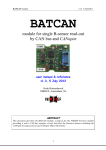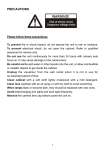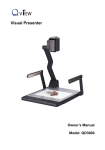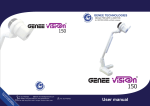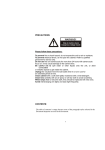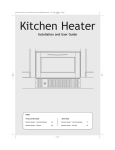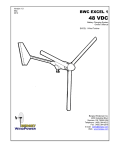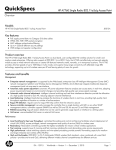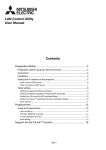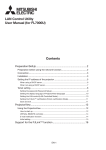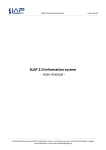Download ProMax
Transcript
PRECAUTIONS Please follow these precautions: To prevent fire or shock hazard, do not expose the unit to rain or moisture. To prevent electrical shock, do not open the cabinet. Refer to qualified personnel for service only. Do not use the unit continuously for more than 24 hours with camera auto focus on. It may cause damage to the camera lens. Be careful not to spill water or other liquids onto the unit, or allow combustible or metallic objects to get inside the cabinet. Unplug the DG880 from the wall outlet when it is not in use for an extended period of time. Clean cabinet with a soft cloth lightly moistened with a mild detergent. Clean lens carefully with an air spray or soft dry cloth to avoid scratching. When lamps flash or become dark, they should be replaced with new ones. Avoid interchanging arm lights and back light frequently. CONTACT: PROMAX TECHNOLOGY, LLC SERVICE CENTER 24453 WOODHAM ROAD, NOVI, MI 48374 USA TEL: (1) 886-9PROMAX FAX: (248) 751-6600 E-Mail: [email protected] Web: www.promax-tech.com CONTENTS: PARTS IDENTIFICATION ............................................................................... 3 1 CONTROL PANEL .......................................................................................... 3 BUTTON INSTRUCTION................................................................................ 4 REMOTE CONTROL ...................................................................................... 5 CONNECTIONS ............................................................................................. 6 BASIC PREPARATIONS................................................................................. 6 OUTPUT MODE AND VERTICAL FREQUENCY (60Hz) ...............................11 PAL/NTSC VIDEO OUTPUTS .......................................................................11 INSTALLING PROMAX VISUALIZER SOFTWARE.......................................11 WORKING ON THE STAGE ......................................................................... 13 WORKING OUTSIDE THE STAGE............................................................... 13 LIGHT ........................................................................................................... 14 ADJUSTING IMAGE SIZE ............................................................................ 14 WORKING WITH NEGATIVES ..................................................................... 15 FOCUSING ................................................................................................... 15 FREEZING IMAGE ....................................................................................... 15 BRIGHTNESS ADJUSTMENT...................................................................... 15 WHITE BALANCE ADJUSTMENT ................................................................ 16 AUTO ADJUSTMENT ................................................................................... 16 TEXT/IMAGE MODE..................................................................................... 16 COLOR AND B&W MODE SWITCH ............................................................. 16 SWITCHABLE VIDEO INPUTS .................................................................... 16 SWITCHABLE RGB INPUTS........................................................................ 16 PROJECTOR ON/STANDBY ........................................................................ 17 PROJECTOR INPUTS SELECTION............................................................. 17 IMAGE ROTATION ....................................................................................... 17 IMAGE REVERSION .................................................................................... 17 INFRARED REMOTE CONTROL ................................................................. 17 PRESET FUNCTION .................................................................................... 17 3 X 3 MULTIPLE SCREEN DISPLAY............................................................ 18 USB PORT.................................................................................................... 18 USB IMAGE CAPTURE ................................................................................ 18 CONTROLLING THE DG880 FROM THE COMPUTER............................... 19 CONTROLLING PROJECTOR USING THE DG880 .................................... 20 2 FOLDING THE UNIT..................................................................................... 24 SPECIFICATIONS ........................................................................................ 25 TECHNICAL SUPPORT................................................................................ 27 PARTS IDENTIFICATION Camera Camera stand Arm lights Button instruction Connectors Back light Remote control slot Connectors Stage Operation panel CONTROL PANEL Rot (Rotate the image) Frz (Freeze the image) Neg (Display film negatives) Text (Switch between image/text mode) Save (Save captured images) Far/Near (Focus far or near) 3 Mem (Multiple Screen Display) Ppw (Control the projector On/Standby) Pin (Projector input signal selection) / (Move the image up/down) POWER (Control the DG880 On/Off) CCD/PC1/PC2 (CCD/RGB input signal selection) S-VIDEO/ VIDEO (S-VIDEO/ VIDEO input signal selection) LAMP (Control the arm lights and back light) AUTO (To auto adjust brightness, auto white balance and auto focus) + T/ W (Zoom in and out) BUTTON INSTRUCTION 4 REMOTE CONTROL POWER (Control the DG880 power On/Off) ROTATE (Rotate the image) FREEZE (Freeze the image) LAMP (Control the arm lights and back light) SAVE (Save captured images) NEG (Display film negatives) MIRROR (V-reverse the image) XGA (Switch between SVGA mode and XGA mode) RECALL (Multiple screen display) TEXT (Switch between image/text mode) B&W (Switch between Color mode and Black & White mode) SPLIT (Image split function) PROJECTOR POWER (Control the projector On/Standby) PROJECTOR INPUT (Projector input signal selection) EXIT (Exit selected function) TELE/ W IDE (Increase and decrease magnification) FAR/NEAR (Focus near or far) 5 AUTO (To auto adjust brightness, auto white balance and auto focus) CCD/PC1/PC2 (CCD/RGB input signal selection) S-VIDEO/ VIDEO (S-VIDEO/ VIDEO input signal selection) VOLUME+/- (Adjust the volume) RED+/- (Increase or decrease the red hue) BLUE+/- (Increase or decrease the blue hue) BRIGHT+/- (Adjust the brightness) (Move the image up/down) SCROLL / CONNECTIONS 7 OUT OUT AUDIO VIDEO S-VIDEO IN AUDIO VIDEO 8 IN AUDIO S-VIDEO AUDIO IN PROJECTOR OUT -COMPUTER- IN OUT-12V- IN Side Panel 18 PROJECTOR MIC USB RGB IN AUDIO IN RS232 #1 AUDIO OUT #2 VIDEO OUT #3 S-VIDEO OUT #4 VIDEO AUDIO IN #5 VIDEO IN #6 S-VIDEO AUDIO IN #7 S-VIDEO IN #8 PC AUDIO IN #9 PROJECTOR Connector #10 COMPUTER OUT #11 COMPUTER IN #12 POWER OUT/IN #13 PROJECTOR RS232 Connector #14 MIC IN #15 USB Connector #16 RGB IN #17 RGB AUDIO IN #18 COMPUTER RS-232 Connector BASIC PREPARATIONS 6 1. Place one hand firmly on the base of the DG880, while carefully lifting up the camera stand using the other hand. 2. Open the arm lights and rotate the camera head until they are properly positioned. Arm lights 3. Making connections: Before making any connections, turn off all the power. Please ensure that the DG880 along with all other equipment to be connected are turned off. Step 1: Connect power source. First connect the power cord to the 12V IN connector. Step 2: Connect to the projector. 7 Rear Panel OUT OUT AUDIO VIDEO S-VIDEO IN AUDIO VIDEO IN AUDIO S-VIDEO AUDIO IN PROJECTOR OUT -COMPUTER- IN OUT-12V- IN RGB Input RS232 Cable Screen Projector Side Panel PROJECTOR MIC USB RGB IN AUDIO IN RS232 Connect the DG880’s PROJECTOR port to the projector’s RGB IN port using the RGB cable. You can also control a projector using the controls on the DG880 by connecting the projector to the DG880 using a 6-pin to 9-pin RS232 cable. Some projector models may require a converter cable in addition to this standard RS232 cable to connect to the projector control port, for the pin locations and shape of some projectors’ control port connector may be different from the connector of a standard RS232 cable. Once the DG880 is connected to the projector, you can control the projector’s power on, standby and input selection using the DG880. (Aside from Hitachi projectors, the Code Writing program that comes with the DG880 is required to access this function.) Step 3: Connect to a desktop computer. 8 Rear Panel OUT OUT AUDIO VIDEO S-VIDEO IN AUDIO VIDEO To the Monitor IN AUDIO S-VIDEO AUDIO IN PROJECTOR OUT -COMPUTER- IN OUT-12V- IN USB Connector RGB Output RS232 Cable Computer PROJECTOR MIC USB RGB IN AUDIO IN RS232 Side Panel Note: You can connect a laptop computer to the RGB IN port of side panel using a RGB cable. Step 4: Connect to the first video equipment with S-Video input. S-Video Cable S-Video out Audio out Video equipment Rear Panel OUT AUDIO OUT VIDEO IN S-VIDEO AUDIO IN VIDEO AUDIO S-VIDEO AUDIO IN PROJECTOR OUT -COMPUTER- IN OUT-12V- IN Projector (or amplifier/speaker equipment) Audio input In the step 2, the connection between the S-video and C-Video output signals to the projector was established, where the RGB cable runs from the DG880 and goes to the projector. Once the connections have been made as detailed in the steps 2, 3, 4, input signals from the computer、 9 DG880 CCD, C-Video and S-Video are going to the RGB1 input on the projector and will be displayed on the projector screen as RGB1. These signals can be seen in turn when pressing “CCD/PC1/PC2” and “S-VIDEO/VIDEO” on the control panel of the DG880. Step 5: Connect to the second video equipment with video input. Video Cable Video out Audio out Video equipment Rear Panel OUT AUDIO OUT VIDEO IN S-VIDEO AUDIO IN VIDEO AUDIO S-VIDEO AUDIO IN PROJECTOR OUT -COMPUTER- IN OUT-12V- IN Projector Color monitor Video in Step 6: Connections for external control from the computer. Side Panel PROJECTOR MIC USB RGB IN AUDIO IN RS232 RS-232 cable USB cable RS 232 connector of the computer USB connector of the computer Use the computer RS232 cable (9-pin to 9-pin) to make the connections displayed below to control the DG880 from an external computer. A USB connection enables the computer to capture still images and/or video streams from the DG880. Special software is required for this 10 operation. 4. Turn on the power by pressing the “POWER” button. OUTPUT MODE AND VERTICAL FREQUENCY (60Hz) The RGB output can output a signal in the SVGA /XGA format. In order to achieve the best picture quality you must set the outputs of the DG880 to match the native resolution of your display unit. PAL/NTSC VIDEO OUTPUTS The S-Video and composite video outputs are set to NTSC (PAL) during manufacturing. INSTALLING PROMAX VISUALIZER SOFTWARE This function allows the user to snap and display images using the USB interface. It includes displaying static and dynamic pictures, snapping dynamic images and playback the dynamic images using the Windows XP media player. A. Connect the computer and the DG880 using the USB cable. Insert the software CD that comes with your purchased DG880 into the CD-ROM drive. Turn on the DG880. The setup will run automatically on your system, and then the Promax Software Setup window will appear as below. 11 B. Click C. Click , you will see the following setup window: and select , you will see the following setup window: D. Click E. Click , then copy files to finish the setup. 12 F. Shut down your computer when prompted in order for the changes to take effect. * Please pay attention to the following: 1. Computer hardware requirement: CPU: 2.4GHz, RAM: 256M or above, Graphic card 64M, USB 2.0 port, Hard disk 40G or more, Monitor display resolution higher than XGA (1024*768). 2. Operating system: Windows XP SP2 (Service Pack 2). 3. Must use a high-speed USB 2.0 cable provided 4. When connecting the DG880 to a desktop computer with the high-speed USB 2.0 cable provided, we recommend using the USB port located on the rear of the mainframe. The USB port on the front of the computer might have interference. 5. You will need to install the USB driver again when you change a computer’s USB port. If this port has the USB2.0 driver installed, there is no need to install the USB driver again. WORKING ON THE STAGE 1. Place your material on the platform. 2. Select the enlargement required using the “ + T” and “ W ” buttons. 3. Adjust the focus using the “Near” and “Far” buttons or “AUTO” button. WORKING OUTSIDE THE STAGE 13 To show a 3-dimensional object using the DG880, place the object on the working surface and adjust the “ + T” or “ W ” and “AUTO” keys. If the object is too large for the stage or if you would like to show it from one of its side, or a different angel, just place the object behind or in front of the unit and manually tilt the camera head (remove the close-up lens prior to titling Rotate 330 degrees vertically the camera head). LIGHT The arm lights are powered on when the power is turned on. Each time you press the “LAMP” buttons, the lighting changes occur as demonstrated. The arm lights turn on The back light turns on All the lights turn off ADJUSTING IMAGE SIZE To reduce or enlarge the image size displayed on the screen, press the “ + T” (Zoom in) or “ W ” (Zoom out) button. 14 WORKING WITH NEGATIVES The DG880 is automatically set to display normal materials on the screen when the power is on. To display negatives, turn on the backlight by pressing the “LAMP” key, and then press the “Neg” button to display the film negatives. Press the “Neg” button again to display normal materials in the color mode. FOCUSING When the DG880 is turned on the focus automatically adjusts to the stage, Only 3D objects require a focus adjustment. Press the “AUTO” button to auto focus. Press the “FAR” or “NEAR” button to focus manually. FREEZING IMAGE To show a still image on the screen, when the output signal is RGB, press the “Frz” button. The frozen image cannot be adjusted (Zoom in/out, color adjustment, etc.). BRIGHTNESS ADJUSTMENT If the image effect is not satisfactory, you can adjust the brightness to get a 15 better image effect. Use the “BRIGHT +” or “BRIGHT -” button to adjust the brightness. To increase the brightness, press the “BRIGHT +” button. To decrease it, press the “BRIGHT -” button. To return to the initial brightness press the “AUTO” button. WHITE BALANCE ADJUSTMENT Each time the lighting condition changes, the user should adjust the white balance of the CCD. Press the “AUTO” button to adjust the white balance automatically. AUTO ADJUSTMENT One of the DG880’s special functions is auto adjustment. Press the “AUTO” button to auto adjust the brightness, the white balance and the focus. TEXT/IMAGE MODE Press the “Text” button to switch between image/text modes. To display a text file, switch to the text mode to get a clearer text effect. COLOR AND B&W MODE SWITCH Press “B&W” once to enter the Black & White mode; press again to return to the Color mode. (On the remote control) VIDEO INPUTS Press the “S-VIDEO/VIDEO” button to switch between S-Video and composite video signals. RGB INPUTS Use the “CCD/PC1/PC2” button to switch between CCD and different RGB signals. Each time the “CCD/PC1/PC2” button is pressed, it provides seamless transitions among different sources such as Camera (CCD), COMPUTER(IN),and RGB (IN). Notes: RGB OUT always outputs RGB IN signals. 16 PROJECTOR ON/STANDBY Press the “POWER” button to turn on the DG880’s power and press the “Ppw” button to turn the projector power on. To place the projector on standby after use, press the “Ppw” button and hold for more than 2 seconds. (Using the remote control, press the “PROJECTOR POWER” button) PROJECTOR INPUTS SELECTION When the projector is connected to several input sources, use the “Pin” button to switch between projector signal inputs. (Using the remote control, press the “PROJECTOR INPUT” button) IMAGE ROTATION In order to rotate the image, press the “Rot” button once, the displayed image will be rotated ±180 degrees clockwise. Continue to press the “Rot” button to restore the image to its initial position. IMAGE REVERSION To display a vertically mirrored image, press the “MIRROR” button. the “MIRROR” button again to exit. Press INFRARED REMOTE CONTROL The DG880’s remote control can control the camera from different angels. On the left side of the visualizer stage, there is a built-in remote control storage compartment where you can store the remote control when it is not in use. Please note that an infrared remote control can only be used up to a certain distance to the unit. Objects situated between the DG880 and the infrared remote control and a weak battery may interfere with the reception. PRESET FUNCTION Use the “SET” button to preset 8 steps of the Zoom/Focus position, when 17 the button is pressed, it moves step by step. (Using the remote control press the “RUN” button to the run preset.) 3 X 3 MULTIPLE SCREEN DISPLAY Press “Mem” button to retrieve images captured and stored in the DG880’s memory. The stored images can be displayed in a 3 x 3 matrix. Press the numeric buttons to display their corresponding images. Under this operation, the “Frz”, “Neg”, “Txt”, “Far”, “Near”, “Ppw”, “Pin”, “↓” and “↑” buttons do not function. Press “Mem” again to exit the 3 x 3 image display mode. On the remote control, the “RECALL” and numeric buttons are the image recall and selection buttons. USB PORT The USB port can be used to store still images from the DG880 in a computer. No additional computer hardware is required. In this way, the DG880 can be used as a 3-D scanner for your computer. Connect the DG880 to your computer with the supplied USB cable. The ProMax DG880 Software is available on the supplied CD-ROM. USB IMAGE CAPTURE You can capture and control images on the DG880 from a computer connected with a USB connector. A. Connect the computer and the DG880 using the USB cable. (you can open this file from the B. Double click X:\ USB Capture\ CD and double click this software, or copy this file into any directory on your computer hard drive and double click it), you will see the following computer control window: 18 The control keys’ operation is identical to the operating instructions of the “Controlling the Visualizer From a Computer” section. C. Menu operation instructions. Close / Open the computer control window. Display the image in full screen. Click to get a present picture frame from CCD. Download the 9 images stored in the DG880 into your desired folder on your computer. Display the current DG880 images continuously (the fastest frame rate is 10 frames per second) Stop image continuous display Choose the image displaying size. Open an image. Save the captured image to computer. CONTROLLING THE DG880 FROM THE COMPUTER You can control the DG880 from a computer connected with a RS232 19 connector. A. Connect the computer and the DG880 using the RS232 cable. B. Double click X:\ 232 Control\Control Panel (you can open this file from the CD and double click it, or copy this file to any directory on your computer’s hard drive and double click to launch it). CONTROLLING PROJECTOR BY VISUALIZER 1. Connect the DG880 to the projector using the RGB、VIDEO、S-VIDEO cables. 2. Connect the computer RS232 cable (9-pin to 9-pin) to the computer’s connector. The DG880’s RS232 port is located on its right side. 3. After completion of the connection, turn the DG880 on. Click [start] -> -> and the following dialog box [All Programs] -> appears as below: When the indicator of “Current RS-232 Connection Status” is green, that means the connection between the DG880 and the computer’s RS232 connector has been made. If the indicator is red, please check the RS232 cable to ensure that it has been connected properly. When all the cables are properly connected, click “Projector” to select your projector model from the drop-down menu, then click “Send”. If you can not find your particular projector model in the “Projector” options, please do the 20 following: 1).Select “Baud rate” and “parity” and input the projector control code. (The baud rate, parity and control code is supplied by the projector’s manufacturer, please refer to the projector’s manual) The input format of projector’s control code is as follows: a. If the data is in the numerical value format, please input data directly, block them off with comma, do not distinguish lowercase and uppercase. For example: the “POWER ON” code in Hitachi projector manual is : BE EF 03 06 00 BA D2 01 00 00 60 01 00 In the POWRER ON box,Input : be, ef, 03, 06, 00, ba, d2, 01, 00, 00, 60, 01, 00. Then use the same input rule to input other code. b. If the data is in the character string format, input ‘character string’. For example: the “POWER ON” code in the SHARP C40/50 projector manual is : P O W ( “-“ is space, E - - - 1 is enter.) In the POWER ON box, input ’POWR 1’, 0d, 0a (Remarks: There are 3 spaces after POWER, 0d, 0a is enter.) Input other codes in the same way. c. If the data is in the numerical value and character format, synthesize the above-mentioned formats. 21 3).Once done, click “Add” to add your projector model, then Click “Send”. Finally, click “Ok”. Now, you can use the DG880 to control your projector. 4. Connect the DG880’s projector control port to the RS232 port with a projector RS232 cable (6-pin to 9-pin). Then use buttons on the operation panel to control the projector. ProMax DG880 provides a 6-pin to 9-pin RS232 cable. If this cable does not match to your projector’s RS232 port, an additional RS232 cable will be needed. This additional RS232 cable can be made based on the pin location of the projector’s RS232 control port. The pin locations of the DG880 are: the pin 1 is RXD (Received Data); the pin 5 is TXD (Transmitted Data); the pin 4 is GND (Ground). Other pins are not defined. The pin location information of the projector is provided by the projector’s manufacturer. The projector’s RS232 control port normally has RXD pin, TXD pin and GND pin, names may vary. The parallel of each data pin is shown as follows: 6 5 Visualizer’s RXD pin------------Projector’s TXD pin 4 3 Visualizer’s TXD pin------------Projector’s RXD pin 21 Visualizer’s GND pin------------Projector’s GND pin 5. If you can not use buttons on the operation panel to control the projector, please use Code-Writing software’s projector control code testing function to check if the control code is correct. Click “Projector” button, the following dialog box appears as below: 22 Connect the DG880 to a computer with a computer RS232 cable (9-pin to 9-pin) and select the Baud Rate and Parity based on the projector’s Baud Rate, then click the “TEST” button to pop up the Projector Code Test dialog box, input the Baud Rate and Parity based on the projector’s Baud rate, then click “Open”. Click the projector control buttons on the DG880’s operating panel to check if the control code that the program received is the same as the sending code. If the receiving code is same to the sending code, the input codes are correct. If the DG880 can not control the projector, please do the following. 1. Check to see if the source control codes of projector are correct. 2. Check to ensure sure the connection between the DG880 and the projector is correct. 23 FOLDING THE UNIT 1. Fold the right arm light down first onto the base, then the left arm down. Rotate the camera head clockwise until the camera head is parallel to the camera stand. 2. Carefully Fold the camera stand down to the front panel. Cautions: a. Do not lay the unit down flat. b. Do not try to stand it on its rear or sides. c. Do not try to pick up this unit by pulling the camera stand. 24 NOT THIS WAY SPECIFICATIONS Color system Pickup device Resolution Total Pixels Lens Zoom Camera Rotation Focus/Iris White balance Negative/positive conversion Black/white and color selection Image Freeze Image Save & Recall Lights NTSC system 1/3″CCD XGA (1024 x 768) 850,000 12 x optical zoom, 8 x electrical zoom F=1.8~2.7 mm / f = 5.4 ~ 64.8 mm Powered Vertically 330° Auto/manual selectable Auto Yes Yes Yes 9 frames save, 3 x 3 multiple screen display Arm light: 1.5W LED lamps x 2 25 Input connectors Output connectors Operating system Hardware Requirement USB connector RS-232 connector USB port Power requirements Dimension (W x D x H) Weight Accessories Back light: 4W LED lamps C Video IN (RCA) (1) S Video IN (4-pin DIN) (1) Audio IN (Mini Jack) (2) MIC IN (phone jack)(1) PC Audio (2) RGB DB15FLC (2) RGB DB15FLC (2) C Video OUT (RCA) (1) S Video OUT (4-pin DIN) (1) Audio OUT (Mini Jack) (1) Windows XP SP2 (Service pack 2) CPU higher than P2.4GHz Memory higher than 256 MB 15~20 frames/sec D-Sub, 9-pin, male / 6-pin PS/2 USB 2.0 12V/4A external AC adapter Folded: 20.1″ x 16.1″ x 4.7″ Setup: 20.1″ x 20.9″ x 22.4″ Packing: 25.6″ x 21.2″ x 9.1″ N.W: 5.5Kg (12.1lbs) G.W: 9.5Kg (20.9 lbs) AC power cord RGB cable Audio/Video cable S-Video cable Computer RS232 cable (9-pin to 9-pin) Projector RS232 cable (6-pin to 9-pin) USB cable Audio convert cable AC adapter 26 User’s manual Quick Start-up guide Software CD Infrared remote control Warranty card * Design and specifications are subject to change without prior notice. TECHNICAL SUPPORT How to Reach Promax: By Phone Call us at (1) 866-9PROMAX. Our expert personnel provide technical assistance from 9:00AM through 5:00PM Eastern Standard Time, Monday through Friday. Please have the following information available before calling: - Product model name(s) and numbers Product serial number(s) Detailed and specific questions Online Technical support is also available online at ProMax’s web site at 27 www.ProMax-tech.com. You can submit your questions and concerns through our online form. Or you can email us at [email protected]. By Mail ProMax Technology, LLC Service Center 50586 West Pontiac Trail, Suite X26C Wixom, Michigan 48393, USA Phone: (1) 866-9-PROMAX Fax: 248-751-6600 Copyrights © 2004 ProMax Technology, LLC. All Rights Reserved. 28




























